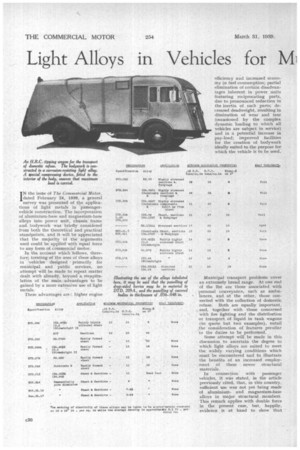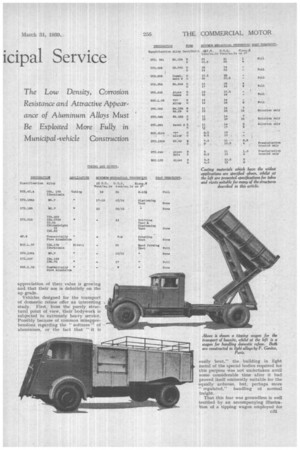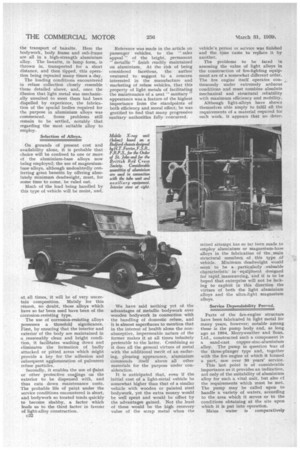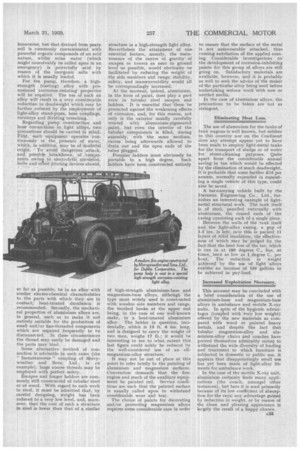Light Alloys in Vehicles for Mi icipal Service
Page 84

Page 85

Page 86

Page 87

If you've noticed an error in this article please click here to report it so we can fix it.
IN the issue of The Commercial Motor,
• 'dated February 24, 1939, a general
survey was presented of the applications of light metals in passengervehicle construction. The incorporation of aluminium-base and magnesium-base alloys into power unit, chassis frame and bodywork was briefly considered from both the theoretical and practical standpoints, and it will be appreciated that the majority of the arguments used could be applied with equal force to any form of commercial motor.
In the account which follows, therefore; treating of the uses of these alloys in vehicles designed primarily for municipal and public services, no attempt will be made to repeat matter dealt with already, beyond a recapitulation of the main advantages to be gained by a more extensive use of light metals. • These advantages are: higher engine Municipal transport problems cover an extremely broad range. At one end of the list are those associated with personal conveyance, such as ambulances, and at the other, those connected with the collection of domestic refuse. Both are equally important, and, together with those concerned with fire fighting and the distribution or transport of liquid in tank wagons (to quote but two examples), entail the consideration of features peculiar to the duties to be performed.
Some attempt will be made in this discussion to ascertain the degree to which light alloys are suited to meet the widely varying conditions which must be encountered and to illustrate the benefits of an increased employment of these newer structural materials.
In connection with passenger vehicles, it was stated, in the article previously cited, that, in this country, sufficient use was not yet being made of aluminiumand magnesium-base alloys in major structural members. This remark applies with double force in the present case, but, happily, evidence is at hand to show that appreciation of their value is growing and that their use is definitely on the up grade.
Vehicles designed for the transport of domestic refuse offer an interesting study. First, from the purely structural point of view, their bodywork is subjected to extremely heavy service. PoSsibly because of common misa.pprehensions regarding the " softness " of aluminium, or the fact that " it is
easily bent," the building in light metal of the special bodies required for this purpose was not undertaken until some considerable time after it hadproved itself eminently suitable for the equally arduous, but, perhaps more " regulated," handling of normal freight.
That this fear was groundless is well testified by an accompanying illustralion of a tipping wagon employed for c31. the transport of bauxite. Here the bodywork, body frame and sub-frame are all in a high-strength aluminium alloy. The bauxite, in lump form, is thrown in, transported for a short distance, and then tipped, this operation being repeated many times a day. The loading conditions encountered in refuse collection closely resemble those detailed above, and, once the illusion that light metal was mechanically unsuited to meet them had been dispelled by experience, the fabrication of the special bodies required for the purpose in aluminium alloys was commenced. Some problems still remain to be settled, notably that regarding the most suitable alloy to employ.
Selection of Alloys.
On grounds of present cost and availability alone, it is probable that choice will be confined to one or more of the aluminium-base alloys now being employed; the use of magnesiumbase alloys, although undoubtedly conferring great benefits by offering absolutely minimum deadweight, must, for some time to come, be ruled out.
Much of the load being handled by this type of vehicle will be moist, and, at. all times, it will be of very uncertain composition. Mainly for this reason, no doubt, those alloys which have so far been used have been of the corrosion-resisting type.
The use of corrosion-resisting alloys possesses a threefold significance. First, by ensuring that the interior and exterior of the body are maintained in a reasonably clean and bright condition, it facilitates washing down and eliminates the formation of badly attacked or pitted areas which might provide a key for the adhesion and subsequent agglomeration of pulverent refuse particles.
Secondly, it enables the use of 45aint or other protective eoalings on the exterior to be dispensed with, and thus cuts down maintenance costs. The probable life of paint under the service conditions encountered is short, and bodywork so treated tends quickly to become shabby, a factor which leads us to the third factor in favour of light-alloy construction.
c3 Reference was made in the article on passenger vehicles, to the " sales appeal" of the bright, permanent " metallic " finish readily maintained on aluminium. At the risk of being considered facetious, the author ventured to suggest to a concern interested in the manufacture and marketing of refuse vehicles, that this property of light metals of facilitating the maintenance of a neat " sanitary " appearance was a feature of the highest importance from the standpoints of both efficiency and moral effect; he was gratified to find that many progressive sanitary authorities fully concurred.
We have said nothing yet of the advantages of metallic bodywork over wooden bodywork in connection with the handling of domestic refuse, and it is almost superfluous to mention that in the interest of health alone the nonabsorptive, impermeable nature of the former makes it at all times infinitely preferable to the latter. Combining as it does all the general virtues of metal with the additional merit of an enduring, pleasing appearance, aluminium Commends itself above all other materials for the purpose under consideration.
It is anticipated that, even if the initial cost of a light-metal vehicle be somewhat higher than that of a similar vehicle with wooden or painted steel bodywork, yet the extra money would be well spent and would be offset by the advantages gained. Not the least of these would be the high recovery value of the scrap metal when the vehicle's period ox service was finished and the time came to replace it by another.
The problems to be faced in assessing the value of light alloys in the construction of fire-fighting equipment are of a somewhat different order. The fire engine itself operates continuously under extremely arduous conditions and must combine absolute mechanical and structural reliability with maximum efficiency and mobility.
Although light-alloys have shown themselves able amply to fulfil all the requirements of a material required for such work, it appears that no deter mined attempt has so far been made to employ aluminium or magnesium-base alloys in the fabrication of the. main structural members of . this type of vehicle. Minimum deadweight would seem to be a particularly yaluable characteristic' in eqiiipment designed for rapid.rnanceuvring, and it is to be hoped that enterprise will not be lacking to exploit in this direction the virtues of both the light aluminium alloys and the ultra-light magnesium alloys.
Service Dependability Proved.
Parts of the fire-engine structure have been fabricated in light metal for many years, however; notable among these is the pump body and, as long ago as 1904. Merryweather and Sons, Ltd., constructed such a component in a sand-cast copper-zinc-aluminium alloy. The pump in question 'was of the three-plunger type and, together with the fire engine of which it formed a part, saw over 30 years' service.
This last point is of considerable importance as it provides an indication, not only of the suitability of aluminium alloy for such a vital unit, but also cf the requirements which must be met. The pump may be called upon to handle a variety of waters, according to the area which it serves or to the conditions obtaining at the site upon which it is put into operation.
Mains water is comparatively
innocuous, but that drained from peaty soil is commonly contaminated with powerful organic compounds of an acid nature, whilst mine water (which might conceivably be called upon in an emergency) is powerfully acid by reason of the inorganic salts with which it is usually loaded.
For, the pump, therefore, a highstrength (casting) alloy with pronounced corrosion-resisting properties will be required. The use of such an alloy will result in a very considerable reduction in deadweight which may be further reduced by the employment of light-alloy stand-pipes, hose couplings, turnkeys and dividing breeching.
Regarding pump construction and hose connections in light alloys, two precautions should be carried in mind. Firat, such equipment • operates 'continuously in the presence of water, which, in addition, may be of doubtful origin. • To avoid dangerous _attack, and possible breakdown, of components owing to electrolytic corrosion, bolts and ofher jointing devices should, so far as possible, be in an alloy with similar electro-chemical characteristics to the parts with which they are in contact; heat-treated duralumin is _recommended. Secondly, the mechanical properties of aluminium alloys are, in general, such as to make it not entirely suitable for the production of small and/or fine-threaded components which are required frequently to be disconnected. In these circumstances the thread may easily be damaged and the parts may bind.
Some alternative method of connection is advisable in such cases (the " Instantaneous " coupling of Merryweather and Sons, Ltd., is an example); large coarse threads may be employed with perfect safety.
Escapes and longer ladders are commonly still constructed of tubular steel or of wood. With regard to such work in steel, it must be admitted that, by careful designing, weight has been reduced to a very low level, and, moreover, that the cost of such a structure in steel is lower than that of a similar structure in a high-strength light alloy. Nevertheless the attainment of one essential feature, namely, the maintenance of the centre of gravity of escapes or towers as near to ground level -as possible, would obviously be facilitated by reducing the weight of the side members and rungs; stability, safety, and manceuvrability would all be correspondingly increased.
At the moment, indeed, aluminium, in the form of paint, does play a part even in tubular • steel escapes and ladders. * It is essential that these be protected against the weakening effects of corrosion, and, for this reason, not only is the exterior usually carefully treated with aluminium-pigmented paint, but even the interior of the tubular components is filled, during assembly, with the same medium, excess being afterwards allowed to drain out and the open ends of the tubes plugged.
Pompier ladders must obviously be portable to a high degree. Such ladders have been constructed entirely
of high-strength aluminium-base and magnesium-base alloys, although the type most widely used is constructed with wooden side members and rungs, the toothed hooks at the upper end being, in the case of one well-known make, in a heat-treated aluminium alloy. The ladder in question, incidentally, which is 13 ft. 6 ins, long, and is designed to carry the weight of two men, weighs 17 lb.; it would he interesting to see to what extent this last figure could safely be reduced by the well-considered use of an allmagnesium-alloy structure.
It may not be out of place at this point to refer briefly to the painting of aluminium and magnesium surfaces. Convention demands that the fireengine and much of the auxiliary equipment be painted red. Service conditions are such that the painted surface is usually called upon to withstand considerable wear and tear.
The choice of paints for decorating and/or protecting magnesium alloys requires some considerable care in order to ensure that the surface of the metal is not unfavourably attacked, thus causing exfoliation of the applied coating. Considerable investigations on the development of corrosion-inhibiting paints for this group of, alloys are still going on. Satisfactory materials are available, however, and it is probably as well to seek the advice of the maker of the particular alloy being used before undertaking serious work with new or untried media.
In the case of aluminium alloys, the precautions to be taken are not so stringent.
Eliminating Heat Loss.
The use of aluminium for the tanks of tank wagons is well known, but neither in this country nor on the Continent does any attempt appear yet to have been made to employ light-metal tanks for the transport of sludge or of water for street-cleaning purposes. Quite apart from the considerable annual saving in tax which would be effected by the elimination of much deadweight, it is probable that some further £15 per annum, normally expended in repainting a single vehicle of this type, could also be saved.
A tar-carrying vehicle built by the Duramin Engineering Co., Ltd., furnishes an interesting example of lightmetal structural work. The tank itself is of steel, panelled externally with aluminium, the domed ends of the casing consisting each of a single piece.
Between the walls of the tank itself and the light-alloy casing, a gap of 3.5 ins, is left; into this is packed 11 layers of Alfol insulation, the afectiveness of which may be judged by the fact that the heat loss of the tar, which is run in at 180 degrees C., has, at times„ been as low as 1 degree C. per hour. The reduction in weight achieved by the use of light 'alloys enables an increase of 150 gallons to be achieved in pay-load.
Increased Exploitation Necessary.
This account may be concluded with a brief consideration of the use of aluminium-base and magnesium-base alloys in ambulance and mobile X-ray units. In spite of the hygienic advantages (coupled with very low weight) offered by the new materials as compared with wood or painted heavy metals, and despite the fact that tubular magnesium-alloy and aluminium-alloy chairs and couches have proved themselves admirably suited to withstand the wide diversity of loading and treatment to which furniture is subjected in domestic or public use, it appears that disappointingly small use has yet been made of light-alloy fitments for ambulance work.
In the case of the mobile X-ray unit, aluminium certainly finds many applications (the couch, amongst other instances), but here it is used primarily because of its low coefficient of absorption for the rays; any advantage gained by reduction in weight, or by reason of the clean and pleasing appearance is largely the result of a happy chance.
























































































































































